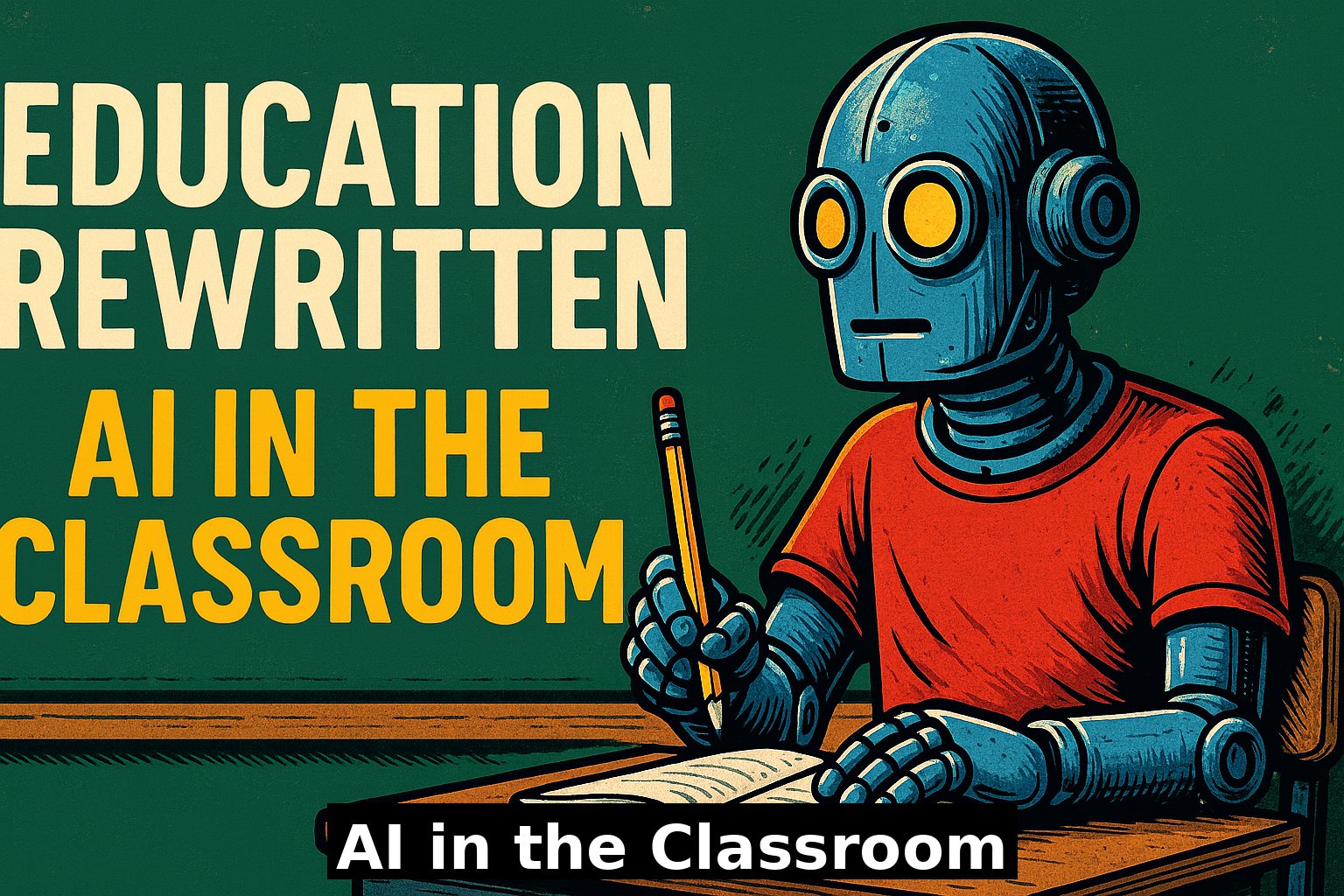This article explores the complex relationship between artificial intelligence and education through real conversations with students and teachers currently navigating this technological revolution.
The Current Reality: AI as Academic Assistant
The integration of artificial intelligence into education isn’t a distant future scenario—it’s happening right now in classrooms across the country. Through candid conversations with 14-year-old student Adeline and elementary teacher Kelsey, we get an unfiltered look at how AI is reshaping the educational experience from both sides of the classroom.
How Students Are Actually Using AI
Adeline’s description of AI use reveals a nuanced picture that goes beyond simple “cheating” narratives. Students are using AI for:
- Homework assistance: Getting explanations for difficult concepts, particularly in mathematics
- Creative projects: Generating images for book reports and character visualizations
- Essay scaffolding: Using AI to help structure and begin writing assignments
- Personalized tutoring: Learning at their own pace in quiet environments
The reality is more complex than critics often portray. Adeline emphasizes that she still reads assigned books and writes her own summaries, using AI selectively rather than as a complete replacement for learning.
The Teacher’s Perspective: Tool, Not Replacement
From the educator’s side, Kelsey describes AI as a productivity enhancer rather than a teaching replacement. Teachers are using AI to:
- Develop lesson plans and brainstorm teaching materials
- Create individualized learning approaches for diverse student needs
- Generate supplementary resources and activities
- Save time on administrative tasks to focus more on actual teaching
This mirrors the broader workplace adoption of AI—it’s becoming a tool that amplifies human capabilities rather than replacing them entirely.
The Accessibility Revolution
One of the most compelling aspects of AI in education is its potential to address long-standing accessibility issues. Adeline’s description of classroom disruptions preventing learning highlights a critical point: traditional classroom environments don’t work for every student.
AI offers:
- Individualized pacing: Students can learn concepts at their own speed
- Quiet, focused environments: Essential for students with attention difficulties
- Immediate feedback: No waiting for teacher availability
- Multilingual support: Particularly valuable for English language learners
- 24/7 availability: Learning doesn’t stop when school ends
This isn’t about replacing human connection but about ensuring all students have access to quality educational support regardless of their circumstances.
The Critical Thinking Debate
The conversation touches on one of the most significant concerns about AI in education: are we outsourcing our thinking? The discussion reveals multiple perspectives:
The Optimistic View
Just as calculators freed us from manual arithmetic to focus on higher-level math concepts, AI could free students from memorizing facts to focus on analysis, creativity, and critical thinking. The process of crafting effective AI prompts itself requires analytical thinking.
The Cautionary Perspective
There’s legitimate concern about over-reliance on AI leading to atrophied reasoning skills. If students consistently turn to AI for answers rather than working through problems independently, they may lose the ability to think critically under pressure.
The Balanced Approach
The key may lie in teaching students when and how to use AI appropriately—treating it like a sophisticated research tool that requires verification and critical evaluation of outputs.
Privacy and Security Concerns
The conversation reveals a significant gap in AI literacy education. While teachers are warned not to input student information into AI systems, many aren’t trained on:
- How to create private AI conversations
- Understanding data retention policies of different AI platforms
- Recognizing potential security vulnerabilities
- Teaching students about digital privacy
This represents a critical area where educational institutions need to catch up quickly.
The Trust Dilemma
An intriguing theme emerges around the question of trust: Do we trust AI or human sources more? The students note that their generation approaches information with healthy skepticism, having grown up with awareness of fake news and manipulated content.
This “trust but verify” approach may actually be beneficial, creating a generation that:
- Questions information sources automatically
- Seeks multiple perspectives on topics
- Understands that both human and AI sources can be fallible
- Values evidence-based reasoning
Looking Forward: Predictions and Possibilities
The conversation reveals several potential trajectories for AI in education:
Short-term (2-5 years)
- Formal AI literacy courses becoming standard curriculum
- More sophisticated AI tutoring systems
- Integration of AI into existing educational platforms
- Development of ethical guidelines for AI use in schools
Medium-term (5-10 years)
- AI potentially reducing time spent in traditional schooling
- More personalized and efficient learning pathways
- AI teaching assistants working alongside human teachers
- Virtual and augmented reality enhanced by AI for immersive learning
Long-term (10+ years)
- Possible fundamental restructuring of educational systems
- Brain-computer interfaces changing how we learn and retain information
- AI potentially handling most information delivery, freeing humans for mentorship and social-emotional learning
- Educational experiences that adapt in real-time to student needs and interests
The Social and Emotional Dimension
Despite the technological possibilities, the conversation consistently returns to the importance of human connection. Students still need:
- Social interaction with peers
- Emotional support from teachers
- Face-to-face communication skills
- The ability to navigate interpersonal conflicts and relationships
The most promising vision isn’t AI replacing teachers but AI handling routine information delivery so human educators can focus on the uniquely human aspects of education: mentorship, emotional intelligence, creativity, and social development.
Critical Questions Moving Forward
The discussion raises several important questions that educational systems must address:
- Equity: Will AI create greater educational equality or widen existing gaps between those with and without access?
- Skill Development: Which human skills remain essential in an AI-augmented world?
- Assessment: How do we evaluate learning when AI can assist with most traditional academic tasks?
- Mental Health: What are the psychological effects of increasing AI dependence on developing minds?
- Authenticity: How do we maintain authentic learning experiences in an AI-mediated world?
Recommendations for Stakeholders
For Educators
- Develop AI literacy for yourself before teaching it to students
- Focus on teaching skills that complement rather than compete with AI
- Emphasize critical evaluation of AI outputs
- Maintain human connection as your primary value proposition
For Students
- Learn to use AI as a tool, not a crutch
- Develop strong prompting and questioning skills
- Always verify AI information through multiple sources
- Don’t lose touch with fundamental skills like reading, writing, and basic mathematics
For Parents
- Stay informed about AI developments affecting education
- Discuss AI ethics and responsible use with children
- Balance AI assistance with independent skill development
- Support schools in developing thoughtful AI policies
For Policymakers
- Invest in AI literacy training for educators
- Develop privacy and security guidelines for educational AI use
- Ensure equitable access to AI tools across all schools
- Create frameworks for ethical AI use in education
Conclusion: Embracing Uncertainty
The conversation reveals a generation of students and teachers navigating uncharted territory with remarkable adaptability and thoughtfulness. Rather than panic or uncritical embrace, what emerges is a nuanced understanding that AI in education presents both tremendous opportunities and significant challenges.
The key insight may be that we’re not just integrating a new tool into existing educational systems—we’re potentially witnessing the early stages of a fundamental transformation in how humans learn and develop. The students and teachers working through these challenges today are the pioneers shaping what education will look like for future generations.
The path forward requires continued dialogue, experimentation, and adaptation. Most importantly, it requires keeping human flourishing at the center of educational goals, using AI to enhance rather than replace the essentially human work of growing, learning, and becoming.
As we stand at this technological crossroads, the voices of current students and teachers provide invaluable guidance. They remind us that behind every discussion of AI capabilities and concerns are real people navigating real challenges, trying to make the best decisions they can with the information available.
The future of AI in education won’t be determined by technologists or policymakers alone—it’s being shaped right now in classrooms across the world by students asking AI for help with math homework and teachers using it to brainstorm better ways to reach their students. Understanding their experiences is crucial for anyone hoping to navigate this transformation thoughtfully and responsibly.

